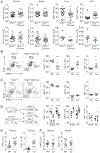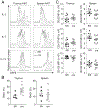The Protein Phosphatase Shp1 Regulates Invariant NKT Cell Effector Differentiation Independently of TCR and Slam Signaling
- PMID: 30796181
- PMCID: PMC6457124
- DOI: 10.4049/jimmunol.1800844
The Protein Phosphatase Shp1 Regulates Invariant NKT Cell Effector Differentiation Independently of TCR and Slam Signaling
Abstract
Invariant NKT (iNKT) cells are innate lipid-reactive T cells that develop and differentiate in the thymus into iNKT1/2/17 subsets, akin to TH1/2/17 conventional CD4 T cell subsets. The factors driving the central priming of iNKT cells remain obscure, although strong/prolonged TCR signals appear to favor iNKT2 cell development. The Src homology 2 domain-containing phosphatase 1 (Shp1) is a protein tyrosine phosphatase that has been identified as a negative regulator of TCR signaling. In this study, we found that mice with a T cell-specific deletion of Shp1 had normal iNKT cell numbers and peripheral distribution. However, iNKT cell differentiation was biased toward the iNKT2/17 subsets in the thymus but not in peripheral tissues. Shp1-deficient iNKT cells were also functionally biased toward the production of TH2 cytokines, such as IL-4 and IL-13. Surprisingly, we found no evidence that Shp1 regulates the TCR and Slamf6 signaling cascades, which have been suggested to promote iNKT2 differentiation. Rather, Shp1 dampened iNKT cell proliferation in response to IL-2, IL-7, and IL-15 but not following TCR engagement. Our findings suggest that Shp1 controls iNKT cell effector differentiation independently of positive selection through the modulation of cytokine responsiveness.
Copyright © 2019 by The American Association of Immunologists, Inc.
Figures






Similar articles
-
TCR signal strength controls thymic differentiation of iNKT cell subsets.Nat Commun. 2018 Jul 9;9(1):2650. doi: 10.1038/s41467-018-05026-6. Nat Commun. 2018. PMID: 29985393 Free PMC article.
-
Discrete TCR Binding Kinetics Control Invariant NKT Cell Selection and Central Priming.J Immunol. 2016 Nov 15;197(10):3959-3969. doi: 10.4049/jimmunol.1601382. Epub 2016 Oct 19. J Immunol. 2016. PMID: 27798168
-
SLAMF6 regulates basal T cell receptor signaling and influences invariant natural killer T cell lineage diversity.Int Immunol. 2025 Aug 4;37(9):563-577. doi: 10.1093/intimm/dxaf030. Int Immunol. 2025. PMID: 40405353
-
mTOR and its tight regulation for iNKT cell development and effector function.Mol Immunol. 2015 Dec;68(2 Pt C):536-45. doi: 10.1016/j.molimm.2015.07.022. Epub 2015 Aug 4. Mol Immunol. 2015. PMID: 26253278 Free PMC article. Review.
-
Invariant NKT cell development: focus on NOD mice.Curr Opin Immunol. 2014 Apr;27:83-8. doi: 10.1016/j.coi.2014.02.004. Epub 2014 Mar 13. Curr Opin Immunol. 2014. PMID: 24637104 Review.
Cited by
-
Development of αβ T Cells with Innate Functions.Adv Exp Med Biol. 2022;1365:149-160. doi: 10.1007/978-981-16-8387-9_10. Adv Exp Med Biol. 2022. PMID: 35567746
-
Intrinsic factors and CD1d1 but not CD1d2 expression levels control invariant natural killer T cell subset differentiation.Nat Commun. 2023 Dec 1;14(1):7922. doi: 10.1038/s41467-023-43424-7. Nat Commun. 2023. PMID: 38040679 Free PMC article.
-
Recent advances in iNKT cell development.F1000Res. 2020 Feb 20;9:F1000 Faculty Rev-127. doi: 10.12688/f1000research.21378.1. eCollection 2020. F1000Res. 2020. PMID: 32148771 Free PMC article. Review.
-
Impact of Aging on the Phenotype of Invariant Natural Killer T Cells in Mouse Thymus.Front Immunol. 2020 Oct 30;11:575764. doi: 10.3389/fimmu.2020.575764. eCollection 2020. Front Immunol. 2020. PMID: 33193368 Free PMC article.
-
Current insights in mouse iNKT and MAIT cell development using single cell transcriptomics data.Semin Immunol. 2022 Mar;60:101658. doi: 10.1016/j.smim.2022.101658. Epub 2022 Sep 28. Semin Immunol. 2022. PMID: 36182863 Free PMC article. Review.
References
-
- Brennan PJ, Brigl M, and Brenner MB. 2013. Invariant natural killer T cells: an innate activation scheme linked to diverse effector functions. Nat. Rev. Immunol 13: 101–117. - PubMed
Publication types
MeSH terms
Substances
Grants and funding
LinkOut - more resources
Full Text Sources
Other Literature Sources
Molecular Biology Databases
Research Materials
Miscellaneous

